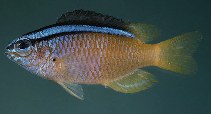| Family: |
Pomacentridae (Damselfishes), subfamily: Pomacentrinae |
| Max. size: |
6 cm TL (male/unsexed) |
| Environment: |
reef-associated; marine; depth range 20 - 65 m, non-migratory |
| Distribution: |
Indo-West Pacific: eastern Indian Ocean (Rowely Shoals), New Guinea, Coral Sea, Solomon Islands, Fiji, Samoa, Guam, and Ryukyu Islands. Eastern Indian Ocean: Australia (Rowely Shoals). Absent from most Indo-Australian coastal reefs (Ref. 1602). |
| Diagnosis: |
Dorsal spines (total): 14-14; Dorsal soft rays (total): 11-13; Anal spines: 2-2; Anal soft rays: 13-14. Description: Body and fins pale yellow, head and anterior of body bluish with a broad deep-blue-edged neon blue horizontal stripe from snout extending across the back up to dorsal fin rear portion. Body depth 2.3-2.7 in SL (Ref. 90102). |
| Biology: |
Adults inhabit rubble and rocky outcrops in sand channels of steep outer reef slopes (Ref. 9710); also on rich coral and algae mixed rubble-like zones on deep slopes. Usually in small groups, staying close to the substrate (Ref. 48636). Feed mainly on copepods. Oviparous, distinct pairing during breeding (Ref. 205). Eggs are demersal and adhere to the substrate (Ref. 205). Males guard and aerate the eggs (Ref. 205). Diurnal species (Ref. 54980; 113699). |
| IUCN Red List Status: |
Least Concern (LC); Date assessed: 03 February 2021 Ref. (130435)
|
| Threat to humans: |
harmless |
| Country info: |
Recorded from Bongo Island and Paril-Sangay Protected Seascape, Moro Gulf (Ref. 106380). |
Source and more info: www.fishbase.org. For personal, classroom, and other internal use only. Not for publication.

